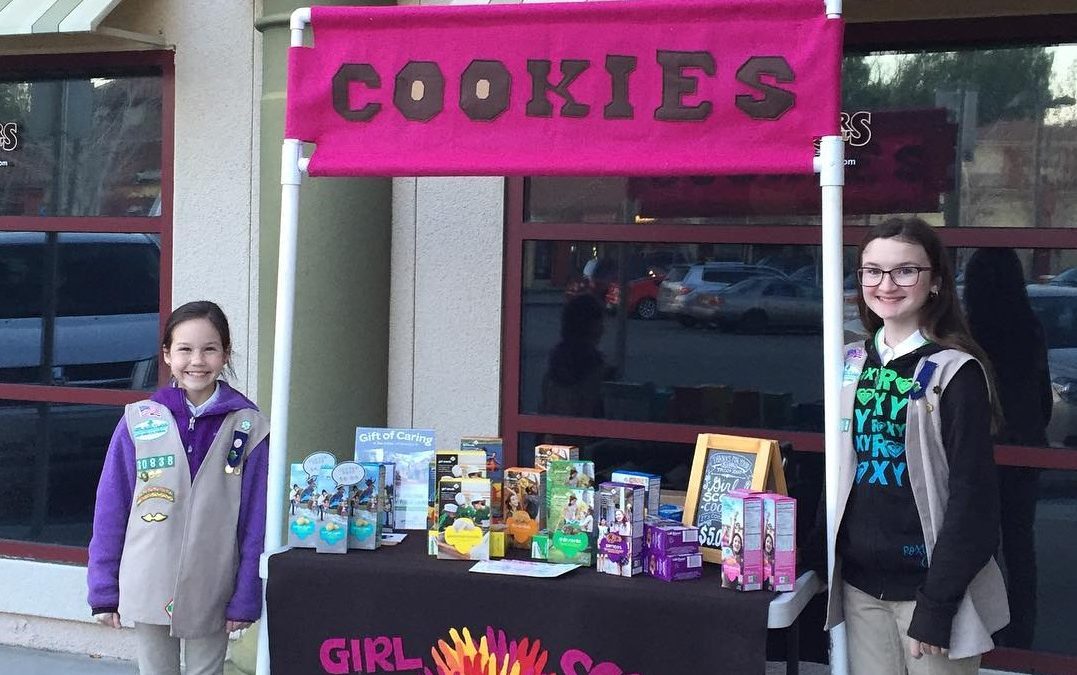We all know selling Girl Scout Cookies help girls develop essential life skills—goal setting, decision making, money management, people skills, business ethics…but the skill-building doesn’t stop there! As girls prepare for the cookie season, they have the chance to tap into their creativity as they personalize their cookie booth. So take this opportunity to get your girls to start thinking like engineers and practice the design process.
Pin this post for later!

Design may sound useful in art, but it’s just as important for STEM! Used by engineers, inventors, and other problem solvers, the design process is a series of steps that help people think creatively and come up with solutions. That’s why it’s no surprise the design process is a key part of the Girl Scouts new STEM Journey on the Volunteer Toolkit, Think Like an Engineer.
These design process steps are powerful tools to help your girls envision and realize the most persuasive (and fun!) way to reach customers and boost cookie sales. In this blog post, I’m going to break down the design process to help you bring girl-led cookie booth design to your next troop meeting and get your girls ready to innovate.
Pro Tip: Remember, you don’t have to do it all on your own—ask troop parents for help. From business innovators who facilitate brainstorming to engineers and garage workshop enthusiasts, you have access to an abundance of useful skills.
Step 1: Define the Need
To capture everyone’s input, use a piece of poster paper and markers, a chalkboard, or a whiteboard. The leader can be the “scribe”, or girls can write ideas on sticky notes – one word or short phrase per note – and add them to the wall.
Start with the big picture. Think about how you can support your girls as they set goals by asking questions like: What does our troop want to accomplish this cookie season?
Then think about how customers interact with a cookie booth. Designers call this the “user experience”
- What do you think attracts customers to a booth? What do they like?
- What questions do customers ask most often?
- Is there anything customers might find confusing?
It’s ok to talk about things that don’t work, too! To an engineer, failure is a good thing, because every time a design fails, you learn something that can make it better.
Step 2: Brainstorm
While brainstorming the cookie booth design, make sure girls know every idea is welcome as they consider questions like:
- What special touches might make the booth more eye-catching?
- How do we share our troop’s story, including our cookie goals?
- How do customers find out what we’re selling?
This can be a great time for “bodystorming”, or brainstorming by acting things out. Think of this as a quick skit, where a few girls play Girl Scouts, and a few pretend to be customers.
Once you have a set of ideas about booth themes, signage, and flow, it’s time to brainstorm a bit about design constraints. These are the requirements for the booth to function well like how you’ll transport, move, and set-up the cookie booth.
Step 3: Design
Once you’ve collected everyone’s thoughts on the booth form (how it looks) and function (how it works), it’s time to put it all together and pick the top few design features for the booth. When choosing features, make sure to think about what will help create a great customer experience!
Have girls collaborate on one design drawing, or break into smaller groups to draw different parts of the booth.

Step 4: Build → Test & Evaluate → Redesign
Consider starting with a small model as a prototype. A “prototype” is a simple model that lets you test out your idea! With a prototype, you can easily modify your design as needed as you consider questions like, “Why do you think it didn’t work?” or “How can you improve your design?” This approach lets girls feel free to invent things without feeling the pressure to make them perfect. Fail Fast. Succeed Sooner: That’s how engineers solve problems.
Prototype your miniature booth using everyday items like:
- Popsicle sticks with hot glue joints (use care, hot glue is very hot!)
- Toothpicks or wood skewers with gumdrop joints
- Chipboard (old cereal boxes) with tape joints
Once you finish your prototype, draw out your design. Add measurements to your drawing, or practice engineering skills by making a scale drawing. Then brainstorm the full-scale booth materials. Cardboard, fabric, wood, and PVC pipe are some popular favorites.
Praise for PVC Pipe
PVC is a great material for building cookie booths! From banner stands and sign holders to special props, PVC is inexpensive, easy to cut, quick to assemble, lightweight, and portable.
For design inspiration and engineering tips, check out Pinterest for PVC ideas, as well as websites with free PVC project plans and tips.
Build it
Collect building materials and tools. Don’t forget to gather any needed safety gear, too!
- Use resources wisely: consider “upcycling” unused materials and borrowing tools.
- Working with unfamiliar materials or techniques? Ask around for troop parents or community members to support the process.
- For ambitious projects, divide the build into parts the troop builds together and smaller parts for girls to complete on their own.
Test & Evaluate then Redesign
Be bold! If something doesn’t work, that’s ok. What are some changes that might help?
The leader’s role in the design process is to guide and support, not give answers or solutions. The easiest way to avoid giving answers is to respond with a question. Girls often have ideas, but are sometimes shy about sharing a “wrong” or “bad” idea. If girls gets stuck and say, “I don’t know what to do,” it can be helpful to ask for options. “That’s ok. Let’s brainstorm. What are some things you could do?”
Pro Tip: Not sure how to accomplish something in the design? Look for similar projects online to see how others solved similar challenges.
Step 5: Share Solutions
Once you have a finished product, get out there with your cookie booth and go for your goals! We’d love to see what your troop designs and hear about your cookie season successes! Snap a picture, write a note, and share it with @GSNorCal on social media.
What to do next:
- Looking to skip the heavy planning? Register for one of our Cookie Booth Makers events! Your troop will be supported through the process, from design to construction, and leave with a custom, portable PVC structure to use for years to come.
- Learn more about how to Think Like an Engineer with the new STEM Journey available on the Volunteer Toolkit.
- Questions? Leave them in the comments section below.

Jessica Henricks—Jessica is a STEM Program Manager for Girl Scouts of Northern California, where she develops and supports NASA-funded Girl Scout Stars space science programs and STEAM experiences. She fondly remembers sleeping outdoors for the first time at Girl Scout Camp Hidden Falls. Before joining Girl Scouts, Jessica created resources, media, and events with organizations like the Exploratorium and Maker Media. In her spare time, she enjoys tinkering in the workshop or going for a paddle on the bay.

